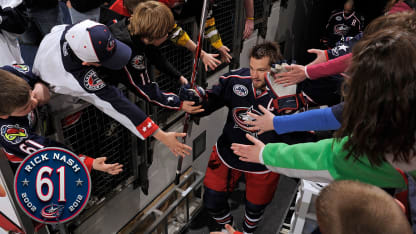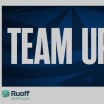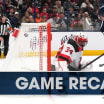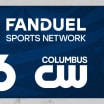Rick Nash isn't one for office décor, but there's one thing that stands out on his desk on suite level at Nationwide Arena.
The McFarlane figurine shows Nash in his white Blue Jackets sweater, looking down at the puck in full concentration. It even came with a detachable stick, one that appears to have been lost to time.
The figure is set in an "ice" base, and in black marker on the white plastic, a message has been scrawled.
"To Jack, happy birthday!" it reads, with Nash's signature underneath it.
On and off the ice, Nash helped make Columbus a hockey town
CBJ star boosted the popularity of the sport, served as a role model for those to come

The Jack, one might guess, was Jack Roslovic. It was signed by Nash when he was a CBJ player and delivered to a young Roslovic long before he made it to the NHL, when the Central Ohio native was a young fan celebrating a birthday and just falling in love with the game of hockey.
"My mom liked to keep a lot of things from when I was younger," Roslovic said recently. "I had a little action figure of him on the ice block that said, 'Happy birthday Jack!" and I found it during training camp last year and gave it to him. It's a funny story."
It's also the perfect example of how Nash ties together the past, present and even future of the Blue Jackets organization and hockey in Central Ohio.
As Nash grew into one of the top players in the NHL -- and someone who became so identifiable with the franchise that
his No. 61 will become the first number retired by the organization Saturday night
-- hockey in Columbus rose with him.
And to see just how far that impact reached, look no further than the locker room at Nationwide Arena. Current CBJ players Roslovic and Dublin native Sean Kuraly grew up sitting in the stands and idolizing Nash, going to games as young kids and dreaming about being just like 61.
Now, they're all members of the same organization, and Kuraly was even a teammate in Boston, with Nash able to see the tangible impact his legacy had on the Columbus hockey community on a daily basis.
"That is a special part of growing with the Blue Jackets that you start seeing these kids that used to come down to Nationwide Arena as fans and grow up playing the game here idolize you," Nash said. "I remember when I got traded to Boston, that was one of the first things Sean told me was he couldn't believe he was sitting beside me, he had a poster of me on his wall. During training camp this year, I think Jack was cleaning out his parents' house and he came to me with one of those McFarlane figurines, and it was, 'To Jack, happy birthday.' He said it was for his 10th or 11th birthday or something.
"It's just little things like that that show how much this city means to me, and what I tried to do was grow the game of hockey in Columbus."

© DAVE MAETZOLD
Building A Foundation
It's a story that's been told many times, but the infrastructure of Columbus hockey took massive steps forward first when the Columbus Chill came to town and then when the Blue Jackets were established.
Prior to the Chill's arrival in 1991, there was just one permanent sheet of ice in town, and that was at the spartan Ohio State Ice Rink on the OSU campus. The immediate, massive success of the ECHL team in a town that had gone more than a decade without a pro hockey team was all the more surprising considering the battles the team had even getting ice in its home building at the Ohio State Fairgrounds.
When Paul Donskov moved his family from London, Ontario, to Columbus in 1990, sons Misha, Anthony and Matt could hardly believe what they found. They moved from one of the most hockey-mad cities in a hockey-mad country to a place where they could hardly skate at all, with registered youth participation in the city struggling to reach 100 players and just one youth organization in town.
The Chill not only caught the imagination of the city, the team spurred the creation of the Chiller ice rinks in Dublin and Easton, increasing the total number of sheets of ice to five in the city. As the Chill wave showed no signs of tapering over the years, Columbus found itself in the market for an NHL team, and after years of efforts, the city was awarded a team in 1997 and the Blue Jackets first stepped on the ice at the sparkling new Nationwide Arena in October 2000.
The immediate reaction was fandemonium, with sellout crowds packing the downtown barn. Two years later, Nash arrived as the No. 1 overall pick in the 2002 draft, and he wasted little time showing his skill when he scored in his first NHL game as an 18-year-old. He tied for the NHL lead with 41 goals a year later, and it's not shocking to hear that pretty quickly, just about every kid in town wanted to wear 61 on his back.
"I think it's a perfect storm," said Ed Gingher, the longtime director of the AAA Blue Jackets junior program. "It was Rick coming in, the market growing, the investment the McConnells and the big club had put into helping grow hockey in Columbus. You have more kids playing, more rinks being built. I think it was a combination of all that, and you had a superstar in Rick Nash that you could market and promote."
"He doesn't realize the impact he had on the market by being the player that he was. He's as humble as they come, but the impact that he had because he was a superstar, there were a lot of eyes on Columbus that might not necessarily have been there if it wasn't for Rick. For him to be the player, the leader and the person that he was, I'm not sure there's a better representative of what Columbus needed at the time than Rick."
And make no mistake, Nash was a superstar during his nine seasons in Columbus. He still holds CBJ records for games played, goals, assists and points, none of which are going to be broken any time soon. His accomplishments included seven 30-goal seasons in union blue, two Olympic appearances in his time in Columbus including a gold medal in 2010, five All-Star game bids and his role as team captain during the first Stanley Cup Playoff season in franchise history.
There were also highlight moments like "The Goal," likely the most memorable tally in franchise history when he weaved past two Phoenix defenders then around the goalie to score a late winner in January 2008, and the goal that sent the Jackets to the postseason in 2009.
"When you're younger, you want to be doing what he's doing," Roslovic said. "He was an electric player to watch. He was the first big deal in Columbus."
"He would deny every bit of that, but he was a superstar," Gingher added. "In my opinion in his prime, there weren't 10 better players than him in the league. He was an impressive player. I think kids gravitated to that. They're watching Connor McDavid, Sidney Crosby now. They were watching Rick back then. It's fun to see that.
"His fingerprints are across youth hockey in Columbus in so many ways even though he was not at the rinks seeing it every day. He's starting to see it now, but it's definitely had an impact all across youth hockey in Columbus."
As Nash's stardom grew, so did the hockey culture in Columbus. Where the Donskov kids had to move back to Canada to get a chance to chase their dreams, the AAA Blue Jackets were established in 2004 to provide high-level hockey experiences to junior players in the area. So far, the program has produced more than 150 players who have gone on to college hockey as well as six NHLers, a list that includes Kuraly, Roslovic and former CBJ player Kole Sherwood.
That's just one piece of the infrastructure in place to grow the game in Columbus, including the Learn to Play efforts of the Blue Jackets to start kids on the ice, a bevy of organizations that sponsor youth hockey at both the house and travel levels, a burgeoning high school scene that has produced programs competitive with the top teams in the state, and more.
Simply put, it's a hockey town, and Nash had a lot to do with it.
"Oh yeah, big time," Anthony Donskov, a longtime teacher and trainer in the sport, said when asked if Nash was the role model for kids. "Now looking back at it, I've been a part of the AAA Blue Jackets for going on 16 years. Rewind back to that time when we were working with some of those young kids in the AAA Blue Jackets organization, and I'll be darned, Rick Nash was the person they were trying to emulate, look up to, have a role model of. ...
"He was an elite talent. He's a great ambassador. He's well spoken, he's polite, he holds the franchise in high regard. It's a win-win situation, so for a young kid coming up in Columbus at that time, if you asked, 'Who is your favorite player on the Blue Jackets?' I'd say nine out of 10 times it's Rick Nash."
Following in Footsteps
The shining examples of that are such players as Roslovic and Kuraly, who would star for the AAA Blue Jackets program, play collegiately at Miami University in Oxford, Ohio, and are now teammates in a CBJ organizaiton that has Nash in the front office as director of player personnel.
Not only did Roslovic have the McFarlane figurine at home, he also had one of Nash's sticks and a pair of gloves that once belonged to the CBJ star. Kuraly, meanwhile, had a Nash signed stick hung above his bed.
"Rick was hockey in Columbus," Kuraly said. "He was every kid's idol that was playing on a pond. You wanted to be Rick Nash, and I was no different. Every Blue Jacket game that you went to, he was the guy you were watching during warmups and trying to pick up on little things that he did and try do the same things. He's just a Columbus legend."
Things came full circle for Kuraly when he established himself as an NHL player in Boston and Nash was traded to the Bruins at the 2018 deadline to provide some extra scoring punch for a potential Stanley Cup run. When Kuraly's teammates found out that he had a Nash stick above his bed as a kid, there was no shortage of ribbing, but it didn't bother Kuraly one bit.
In the end, being teammates with his childhood idol made it worth it, even if there were some unintended consequences.
"We were actually injured at the same time, so we had skill practice," Kuraly said. "I would joke with the skills coach that he would have to make two separate practices for me and Rick as far as difficulty levels. It was me and him out there, so I was just kind of trying to watch was Rick was doing all the time. To share ice with him and see him at the top of his game, it was really cool for me."
Almost two decades after Rick arrived in Columbus in 2002, first spying Nationwide Arena from I-670 as he was driven downtown from the airport, he has become synonymous with hockey in so many ways in the capital city.
As a man who has touched so many parts of not just the Blue Jackets organization but Columbus in general, it's only fitting that his name and the No. 61 will live on in history.
"I think obviously once the Blue Jackets came, hockey got much more popular quickly, but with Rick coming in and being a young kid, I think a lot of the younger kids looked up to him," said Andrew Cassels, a former teammate who has worked as a youth hockey instructor in Columbus after his retirement. "They saw how good he was and how well he played the game, and it's inspiring to a lot of people to see that and have a player that inspires you. I think Rick did that for a lot of young kids.
"You see No. 61 out there a lot even though he's not playing anymore. He's had a huge impact on our game."

















